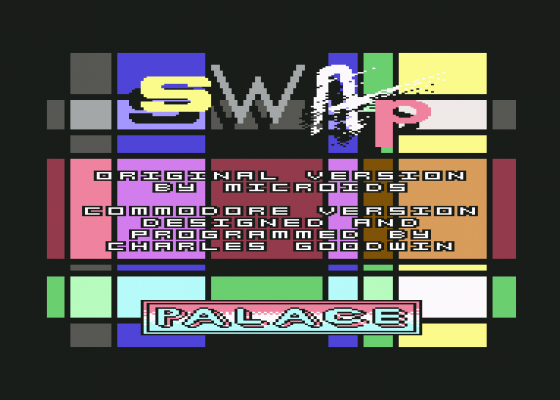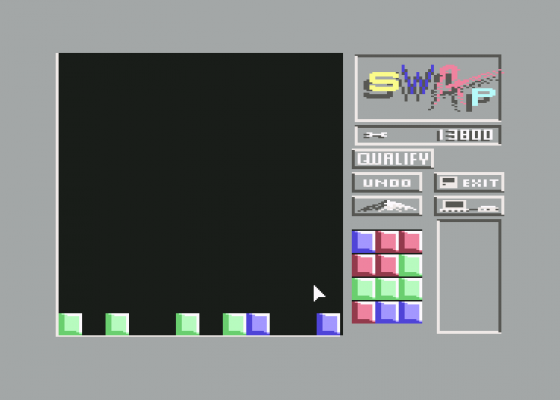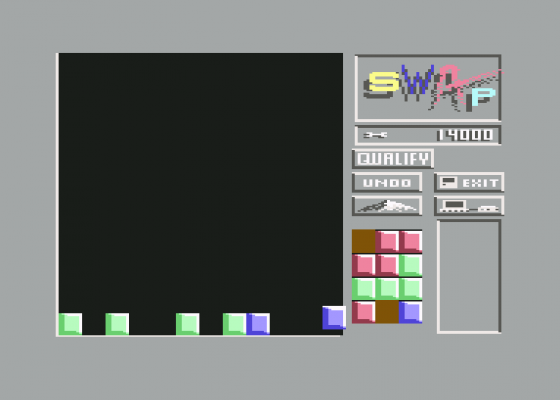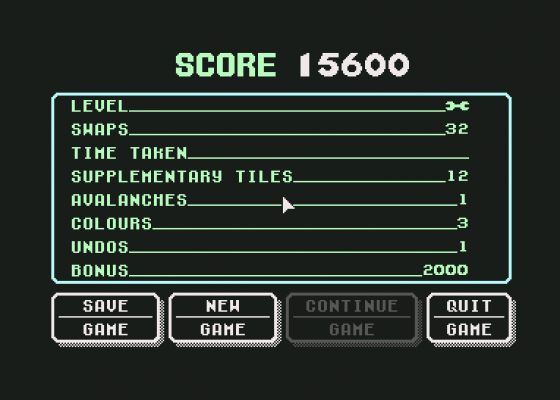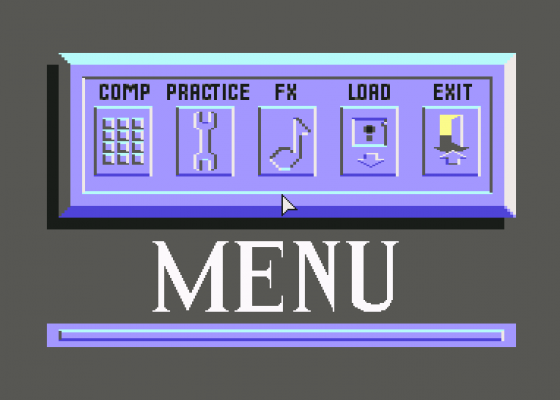
Commodore Format
 1st November 1991
1st November 1991
Categories: Review: Software
Publisher: Palace
Machine: Commodore 64/128
Published in Commodore Format #14
Palace have been pretty quiet on the C64 scene for a while now. Well, totally silent actually. Their last game, International 3D Tennis, was so long ago, most of you probably haven't even heard of them! Anyway, they're back, they've got a new game, and it's a puzzler called Swap.
SWAP (Palace)
At the start of each level, you're faced with a board chock-a-block full of coloured tiles. Your aim (as if you couldn't guess) is to remove as many of the tiles as you can. This is achieved by swapping adjacent tiles to form pairs, triplets or quartets of similarly coloured tiles. Any tiles of the same colour which touch are removed from play.
As you move the pointer around, edges are highlighted to indicate which tile pairs will be swapped. The merest tap on the fire button, and both tiles switch places.
The puzzle aspect arises when you have lots of different colours all over the screen. You then have to start planning ahead; moving colours into groups so that a further swap will join them all together.

If you're running out of tiles to pair up, click on 'Avalanche'. This causes any remaining tiles to fall down the screen. When they come to rest, any touching colours are removed and the pile drops a little further. This option is hugely useful - in fact, the first 30 (or so) levels are a doddle because of it. A few random swaps followed by an Avalanche usually does the trick.
Nevertheless, to be assured of a bash at the next level, you must first qualify. This involves removing a set number of tiles (as indicated on the status panel) at which point a neat jingle plays to herald the fact. You can then exit the level, check your game statistics and click on the 'Next Level; box.
Of course, just when you get the hang of coping with square tiles, they throw triangles and hexagons at you. And that's just the beginning. You soon encounter the credit system where each move involves earning and expending credits (for instance, getting rid of five coloured tiles with one swap warns you three credits). These are amassed as silver and gold ingots and are 'spent' on the more useful options, such as Avalanche. In truth, this credit system is a real pain. It removes a lot of the freedom to experiment and restricts your choice of moves, making an already tricky game very tough indeed.
Swap is enjoyable at first, but I grew bored of it quite quickly (not long after the credit system started, coincidentally). There are 999 levels, but I had trouble getting past level 50. A screen full of tiles can be pretty daunting and on several occasions I just thought "Blimey!" and gave up. It's pretty, slick and undoubtedly very clever, but if you're the sort of chap that has to peel the sticky colours off a Rubik's cube to finish it, beware.
Bad Points
- Later levels are annoyingly complex - you have to plan many moves in advance and it's all a bit too much.
- Poorly graded difficulty: you zoom through the first 30-40 levels, and then grind to a halt.
- 999 puzzles - but they're all much the same.
Good Points
- Incredibly well coded - slicker than a British beach!
- Sound effects are superb.
- Good range of options, including merciful save game and neat practice mode.
- Definitely mainline brain straining for puzzle addicts.
- The visuals simply could not have been done better.
- There's no finishing this one in an evening.
Other Reviews Of Swap For The Commodore 64/128
Swap (Palace)
Phil King swaps his football for coloured tiles and goes flipping mad!


